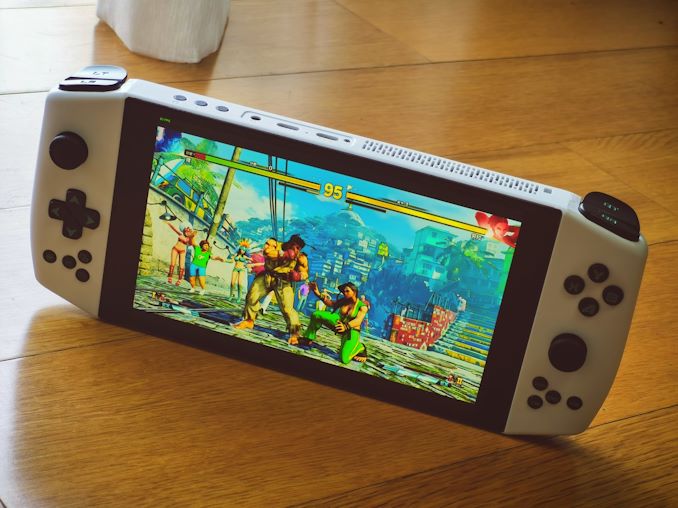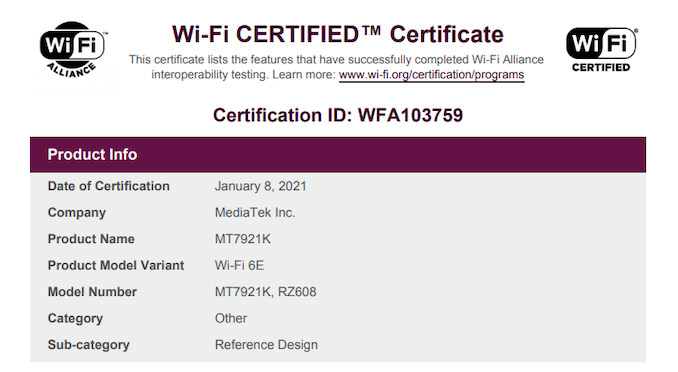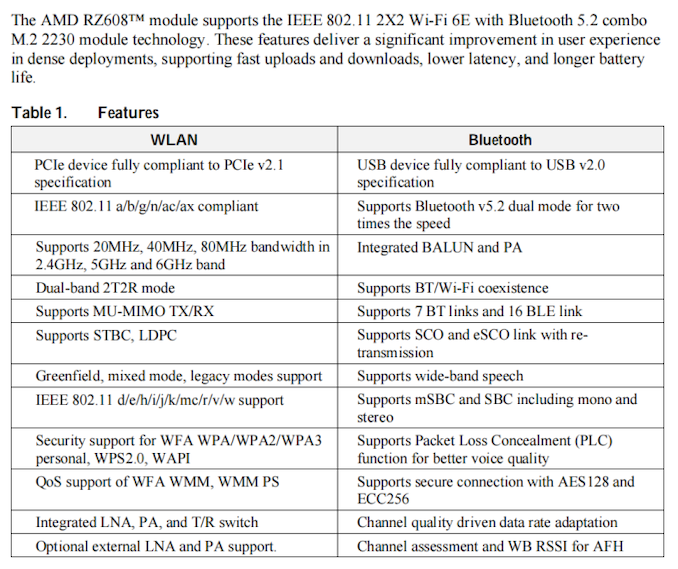AMD's Wi-Fi 6E Module: The RZ608
by Dr. Ian Cutress on May 10, 2021 5:34 AM EST
One of the elements of building a complete end-to-end solution means having all the components under one brand. The complexity of modern gadgets means that having everything made under one company is near-on impossible - especially with the wealth of IP and patents in every small segment of the modern electronic device. To facilitate the appearance of uniform branding, companies will often rebrand the components under their own name. Introducing the AMD RZ608, a Wi-Fi 6E 2x2 wireless module!
As discovered by Laczarus, the new handheld device called the AYANEO uses a wide array of AMD components, starting with the AMD Ryzen 5 4500U mobile processor which is a six-core Zen 2 chip with Vega 6 graphics. It also has a 7-inch display, and it runs a full version of Windows in a handheld device, something akin to an x86 competitor to the Nintendo Switch, albeit crowdfunded and currently shipping to initial backers.
On an update posted to the crowdfunding site on May 9th, the developers behind the project announced that their second batch of 2000 units will be using an unannounced AMD Wi-Fi 6E module. The post states that the AYANEO might very well be the first device with this module in production, and they leverage their cooperation with AMD for the integration with this part as well as troubleshooting. It is also noted that the AMD solution is slightly more expensive than the standard Wi-Fi 6 that was initially part of the design.
So here comes the crux: AMD doesn’t make the Wi-Fi module. Through our sleuthing, this is actually a rebranded MediaTek MT7921K module with an AMD logo on it. MediaTek sells the modules to AMD who brands them, but also leverages the regulatory compliance that MediaTek has already done for this product. AMD then takes over custom integration projects, sales, marketing, and support for the module. The RZ608 sold by AMD is in an M.2 2230 form factor and uses PCIe 2.1, although the AYANEO likely is using a more custom integration. There is also Bluetooth 5.2.
The use of the partnership with MediaTek will likely allow AMD to partner its mobile processors with its own branded Wi-Fi 6E solution with OEM partners when it comes to designing devices. Intel leverages the fact that it has Intel CPU, Intel Wi-Fi, Intel Thunderbolt, and Intel Ethernet as a combined sales opportunity for OEMs making devices around an Intel product, so it appears that AMD is leveraging the same ecosystem gains, albeit with rebranded components.
There was an unconfirmed rumor going around the internet last year about a collaboration between MediaTek and AMD co-creating some custom wireless designs, with some reports suggesting that the collaboration will go beyond Wi-Fi. We're not sure to what extent AMD has had any input in the design of the MT7921K / RZ608, or how much that will continue going forward. At this point I'm confident that this sits as a rebrand just for now, given the lifecycle of product development in this area, as well as the Wi-Fi certification being in MediaTek's name.

Wi-Fi Alliance Certification of MT7921K/RZ608












51 Comments
View All Comments
Matthias B V - Monday, May 10, 2021 - link
What I am curious is if AMD / MediaTek create deeper integration of the WiFi / 5G chips. Like Intel did with their WiFi.brakdoo - Monday, May 10, 2021 - link
There is no reason to do that. Even Intel is not doing CnVi for their AX210 at this time.That was just for marketing (you probably know Intel). Even many smartphones opt for PCIe/USB chips now. Splitting baseband and analog made no sense from a technology point (for Intel) because the baseband part ain't even worth $1 of MCU/DSP...
jeremyshaw - Monday, May 10, 2021 - link
To be fair, Intel doesn't make all of their WiFi solution inhouse. The critical RF front end is typically made by UMC, who holds IP for fabing that.Matthias B V - Monday, May 10, 2021 - link
UMC only fabs it or designs it too as part of their IP. It doesn't matter who fabs it but who designs it in this case I think.kepstin - Monday, May 10, 2021 - link
As far as it goes, Mediatek bought Ralink's wireless business. They're actually one of the better manufacturers of wifi hardware right now. They provide one of the more popular platforms for Wifi 6 and 6E routers (which generally run Linux; they have been decent at getting wifi support into open-source kernels).The unknown at this point is mostly what the quality of Mediatek's windows drivers for the wifi card is like.
Alistair - Monday, May 10, 2021 - link
I hope this company lasts long enough to get some more powerful custom stuff from AMD. Why not 12 cores of RDNA2 for example. And USB4.Matthias B V - Monday, May 10, 2021 - link
I would expect your request to be matched Q1/2022 for APUs and Q3/2022 for Desktop CPUs.Somehow I am curious about the Zen5 rumors with big.LITTLE AMD design. By then you could see an amazing hybrid cpu with a RDNA3 chiplet and maybe Infinity cache for the APU on 3nm.
You could create amazing notebooks and tablets.
nandnandnand - Monday, May 10, 2021 - link
Infinity Cache on RDNA2 is like L3 SRAM. I would like to see gigabytes of L4 cache stacked near CPU cores. Such as on top of the I/O die in current desktop designs.As for the big.LITTLE rumor, you could make a list of features to lop off, like SMT, AVX-512 (AVX2?), cache sizes, and end up with a new Bobcat/Puma that's at least 50% smaller than a normal core. Then throw some amount of those on a chiplet or die. Coming out a couple years after Lakefield and Alder Lake, Windows and Linux will be better prepared for heterogeneous x86.
Matthias B V - Monday, May 10, 2021 - link
I agree on future chiplet / tiles designs and stacked memory. But not sure how fast this will be the case.But yeah I can see custom APUs made from CPU chiplet or even differentv big / little chiplets + GPU chiplets + I/O + Memory + application specific ASIC/FPGA chiplets
I would hope for SVE2 like instructions on x86. It would be nice in general and probably also a solution for better big and small cores integration. We have seen all those as a single thing - yet it has to come all together.
I would expect with RDNA4 + Zen 6 latest for AMD and LunarLake for Intel. Maybe we are lucky and see it with MeteorLake and Zen5 before. Question is to what extend. However 2024/25 should be a reasonable expectation for a fully chiplet design chip being common.
e36Jeff - Monday, May 10, 2021 - link
Assuming AMD's bit.LITTLE design is based on the patents they have filed, it will be unlike any implementation of that chip style we have seen so far. In the patents they describe a system where the L1 cache is either shared or kept in lock-step between the little cores and the big cores. The big cores would have most of their transistors kept unpowered, except for the L1 and things needed to operate that. The little cores would be cut down and unable to process more power-hungry features. When something comes along that requires the big cores attention, it would power on, already have all the data it needs in the L1, run the instructions, then power off. To the OS there wouldn't be 2 cores, it would just see a single, full-featured core, all the juggling of data between the big and little cores would happen in silicon. If done right, it has the possibility of being incredibly powerful and flexible, much moreso that existing silicon. And it requires zero OS changes to work.